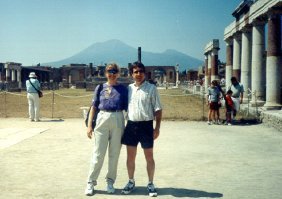

The volcano Vesuvius is located about 4 ½ hours (by bus) south of Rome in the area called Campania. It sits very near to the water's edge between the present cities of Naples and Sarrento. In 62 AD, an earthquake shook the entire area, damaging many of the cities and buildings and killing many of the people. Repairs were still being made when, in 79 AD, Vesuvius erupted burying the entire area from Herculaneum (to the north of Pompeii) down to Stabiae in the south.
Before 79 AD, Vesuvius was considered extinct and therefore had vineyards covering it, as well as large homes and farmhouses. In the afternoon of August 79 AD, Vesuvius began an eruption that would last for 3 days and nights. Flames were first sent high into the sky, followed by a huge black cloud so thick it blocked out the sun. Volcanic matter then rained down from the dark sky bringing with it lightning, earthquakes and tidal waves. Herculaneum received the lava flow which in some areas was 100 feet deep, while Pompeii was buried by the ash. Building started to collapse. Poisonous gasses that were heavier than air were released overcoming the people who were trying to run away. The ashes continued to come down, at times mixed with water, they buried the entire area up to 20 feet deep. Only the tops of the large buildings could be seen. Further and smaller eruptions eventually buried the city completely, altering the coastline and therefore hiding the location of Pompeii for almost 1,700 years.
At the first signs of eruption most of the people fled the city. Of the 20,000 residents of Pompeii, 2,000 stayed and died.
The city streets were paved with stone - carts drove down the roads for so long that the streets became deeply grooved in areas by the wheels. The streets were built lower than the sidewalks to channel rainwater - stepping-stones were added to the streets to allow the pedestrians to cross without getting their feet wet. These stones were set far enough apart to allow the carts to pass. Also, the high curbs had holes cut in them where people tied their horses.
As with most Roman cities, there was a central forum area for public gatherings, auctions, the working of the government, and religious life, etc. It was restricted to people walking only by tall, closely set stones set at the end of all the streets that access it. It was large enough to hold all the residents of the city at one time.
The Temple of Apollo (to the left of the forum) was dedicated to the God around the 5th century BC. The bronze statues of Apollo and Diana flank the sides. In front of the temple stands a sundial column.
The door to the Building of Eumachia stands on the right side of the forum. Weavers, dyers and launderers used this building. This was Pompeii's largest industry. On the outside of the building's large door were two podiums most likely used auctions of cloth.
Some of the bodies were found huddled together, some died curled up with their hands coving their face and some are lying prone covering their heads to protect themselves. Even animals and pets were discovered.
The Forum Baths contained the typical features of Roman baths: dressing
rooms, cold-water bath (frigidarium), warm-water baths (tepidarium), hot-water
baths (calidarium) and separate baths for men and women.